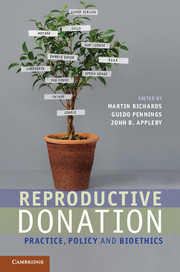Book contents
- Frontmatter
- Contents
- Contributors
- Acknowledgements
- 1 Introduction
- 2 The biology of donation
- 3 Ethics for reproductive donation
- 4 Parenthood – whose right is it anyway?
- 5 Reproductive donation
- 6 UK and US perspectives on the regulation of gamete donation
- 7 Gamete and embryo donation
- 8 The legal and ethical regulation of transnational donation
- 9 Balancing ethical criteria for the recruitment of gamete donors
- 10 Challenges in intra-family donation
- 11 ARTs and the single parent
- 12 Reproductive donation and justice for gay and lesbian couples
- 13 Is disclosure in the best interests of children conceived by donation?
- 14 Identifiable donors and siblings
- 15 Ethical issues in embryo donation
- 16 Reproduction through surrogacy
- 17 Some conclusions regarding the interaction of normative and descriptive elements in reproductive donation
- Index
- References
3 - Ethics for reproductive donation
Published online by Cambridge University Press: 05 August 2012
- Frontmatter
- Contents
- Contributors
- Acknowledgements
- 1 Introduction
- 2 The biology of donation
- 3 Ethics for reproductive donation
- 4 Parenthood – whose right is it anyway?
- 5 Reproductive donation
- 6 UK and US perspectives on the regulation of gamete donation
- 7 Gamete and embryo donation
- 8 The legal and ethical regulation of transnational donation
- 9 Balancing ethical criteria for the recruitment of gamete donors
- 10 Challenges in intra-family donation
- 11 ARTs and the single parent
- 12 Reproductive donation and justice for gay and lesbian couples
- 13 Is disclosure in the best interests of children conceived by donation?
- 14 Identifiable donors and siblings
- 15 Ethical issues in embryo donation
- 16 Reproduction through surrogacy
- 17 Some conclusions regarding the interaction of normative and descriptive elements in reproductive donation
- Index
- References
Summary
The growing use of assisted reproductive technologies (ART) poses a myriad of ethical dilemmas that clinicians, gamete donors and recipients, policy makers and others confront each day around the world. These dilemmas underlie the development and implementation of a range of institutional, professional and public policies. But various stakeholders view, interpret and respond to these conundrums in different ways that must be taken into account, and that generate numerous social science research questions.
In recent years, scholars and others have increasingly sought to build bridges between bioethics and social science (Ives, 2008; Ives and Draper, 2009). These efforts stem in part from heightened awareness of the fact that philosophical approaches to bioethics can be abstract in ways that make them difficult to apply in ‘real world’ settings. In addition, bioethics seeks to examine the ethical, legal and social implications of advances in biotechnology, necessitating multidisciplinary approaches, and posing questions as to how such integration can, or should best occur (Strech, Synofzik and Marckmann, 2008).
This book attempts to both engage in, and comment upon, these intersections between bioethics and social science, illustrating how these two sets of disciplinary realms can enrich each other, through complementary and integrative approaches and insights.
- Type
- Chapter
- Information
- Reproductive DonationPractice, Policy and Bioethics, pp. 30 - 50Publisher: Cambridge University PressPrint publication year: 2012
References
- 2
- Cited by

